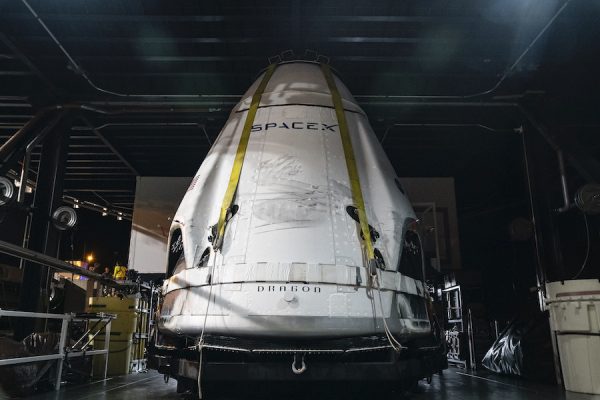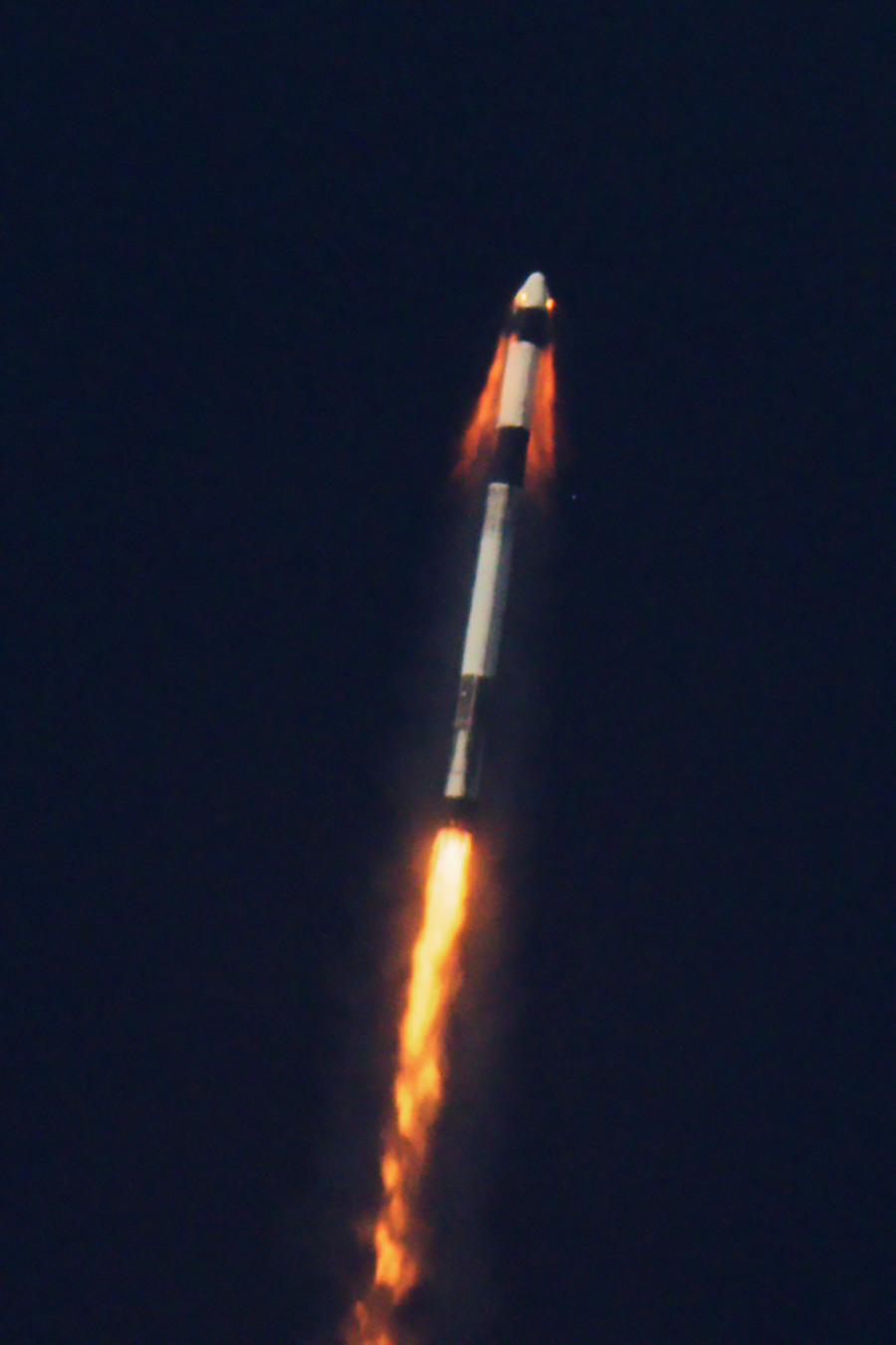SpaceX releases preliminary results from Crew Dragon abort test – Spaceflight Now

Data from the Jan. 19 in-flight launch escape demonstration of SpaceX’s Crew Dragon spacecraft indicate the performance of the capsule’s SuperDraco abort engines was “flawless” as the thrusters boosted the ship away from the top of a Falcon 9 rocket with a peak acceleration of about 3.3Gs, officials said Thursday.
The Jan. 19 test demonstrated the Crew Dragon’s ability to safely carry astronauts away from a launch emergency, such as a rocket failure, and return the crew to a parachute-assisted splashdown in the Atlantic Ocean.
For its final full-scale test before astronauts ride it into space, the Crew Dragon spacecraft lifted off at 10:30 a.m. EST (1530 GMT) on Jan. 19 from pad 39A at the Kennedy Space Center in Florida. A Falcon 9 rocket carried the capsule aloft — just as it would on a crewed mission — for the first 85 seconds of the mission.
The Crew Dragon began its launch escape maneuver at 10:31:25 a.m. EST (1531:25 GMT) — initiated by a low setting of an on-board acceleration trigger — when the Falcon 9 was traveling at a velocity around 1,200 mph (536 meters per second), according to SpaceX.
Eight SuperDraco thrusters immediately pressurized and ignited as the Falcon 9 rocket’s first stage engines were commanded to shut down as part of the abort sequence.
The escape engines on the Crew Dragon produced nearly 130,000 pounds of thrust at full power. The SuperDracos performed flawlessly, SpaceX said, accelerating the capsule away from the top of the Falcon 9 at a peak acceleration of 3.3Gs.
The SuperDracos accelerated the spacecraft from about 1,200 mph up to more than 1,500 mph (about 675 meters per second) in approximately seven seconds, according to SpaceX.

While the Crew Dragon boosted itself away from the Falcon 9, the rest of the rocket was expected to break apart from aerodynamic forces. It did just that, disintegrating suddenly in a fireball as the crew capsule safely sped away.
Although the Falcon 9 erupted in a fireball seconds after the Crew Dragon escaped the rocket on the Jan. 19 abort test, the crew capsule is designed to get away from a rocket even if it explodes or breaks apart with little warning, according to Elon Musk, SpaceX’s founder and CEO.
“In principle, the system is designed to withstand an adverse booster explosion … that happens even before the escape event,” Musk said at a press conference after Sunday’s abort test. “So it’s it’s intended to be very robust, in principle. And … it’s less of an explosion than it is fire. It’s a fireball, but it’s more for a fireball than it is an over overpressure event like an explosion.
“And since the spacecraft has a very powerful base heat shed and even the leeward side heat shield, it should be really not significantly affected by a fireball,” Musk said. “So it could quite literally — like something out of Star Wars — fly right out of the fireball. Obviously, we want to avoid doing that but. But it is really meant to be something that can fly out of the fireball.”
Unlike other crew capsules, such as Russia’s Soyuz spacecraft and NASA’s Orion deep space exploration vehicle, the Falcon 9 and Crew Dragon do not have a large abort tower mounted to the top of the rocket. The Soyuz and Orion capsules use solid-fueled “tractor” abort systems that pull the spacecraft away from its launch vehicle in the event of a failure.
The Crew Dragon uses SuperDraco engines fed by hydrazine and nitrogen tetroxide propellants to push the capsule away from a failing rocket.
Musk said the Jan. 19 abort test appeared “picture-perfect” at first glance.
SpaceX said the telemetry signal from the Falcon 9 rocket halted around 11 seconds after the escape burn, suggesting a “comfortable” distance of about 4,900 feet (1.5 kilometers) between the Crew Dragon and the Falcon 9 fireball.
The Crew Dragon reached a top speed on the abort test of about Mach 2.3, and a maximum altitude of more than 131,000 feet (40 kilometers).
The capsule jettisoned its unpressurized trunk section, which fell to the Atlantic Ocean, before deploying parachutes to slow itself for splashdown.
The drogue chutes deployed at an altitude of about 19,000 feet (5.8 kilometers), and the Crew Dragon’s four main chutes unfurled around 6,500 feet (2 kilometers) above the ocean.
The capsule splashed down in the Atlantic Ocean around 26 miles (42 kilometers) east of the launch site at 10:38:54 a.m. EST (1538:54 GMT), just under nine minutes after liftoff, according to data released by SpaceX.
Recovery teams picked up the capsule from the sea and hoisted it on the deck of SpaceX’s Crew Dragon retrieval ship — named Go Searcher — for the trip back to Port Canaveral. The spaceship returned to port less than nine hours after launch, demonstrating SpaceX teams can quickly return the capsule to land after a splashdown close to shore.
With the Crew Dragon in-flight escape test complete, engineers will analyze additional data over the coming weeks to verify everything functioned as designed. Assuming no showstoppers, the abort demonstration was the final planned test flight of a full-scale Dragon capsule before NASA clears the commercial crew ferry ship to carry astronauts Doug Hurley and Bob Behnken to the International Space Station.
At least two more drop tests to test the Crew Dragon’s parachutes are planned beginning in mid-February.
The parachutes and launch abort propulsion system have been the primary drivers of Crew Dragon schedule delays over the last year. SpaceX encountered chute failures during the capsule’s development, and an explosion destroyed a Crew Dragon spacecraft during an attempted ground test-firing of its SuperDraco thrusters last year.
While data reviews are underway, NASA is evaluating whether to extend the duration of the Crew Dragon’s first piloted test flight from a week-long mission to the space station to a longer stay that could have Hurley and Behnken live and work aboard the orbiting outpost for months.
Officials said they will factor in the astronauts’ training schedules — which may be lengthened if they’re approved for an extended stay at the space station — and the schedule of other crew rotation missions to the orbiting research lab before setting a target launch date for Hurley and Behnken.
NASA and SpaceX said after the Jan. 19 abort test that the first Crew Dragon launch with astronauts could occur in the second quarter of this year, between the beginning of April and the end of June.
SpaceX’s Crew Dragon spacecraft and Boeing’s Starliner crew capsule are in the final stages of testing before NASA approves the vehicles to carry astronauts. NASA has multibillion-dollar contracts with both companies to develop the human-rated spaceships.
Both capsules are designed to end NASA’s sole reliance on Russian Soyuz spacecraft for crew rotation missions to the space station, an operating scheme NASA has been in since the retirement of the space shuttle in 2011.
Email the author.
Follow Stephen Clark on Twitter: @StephenClark1.






